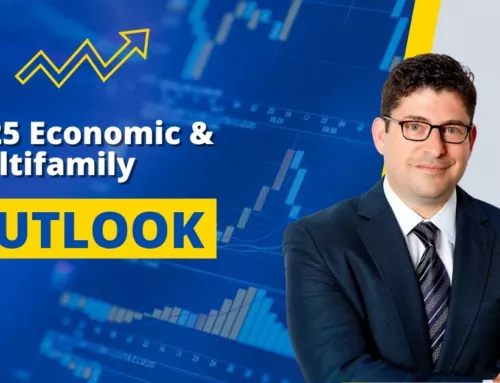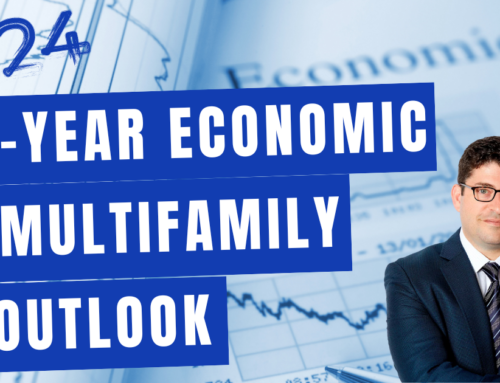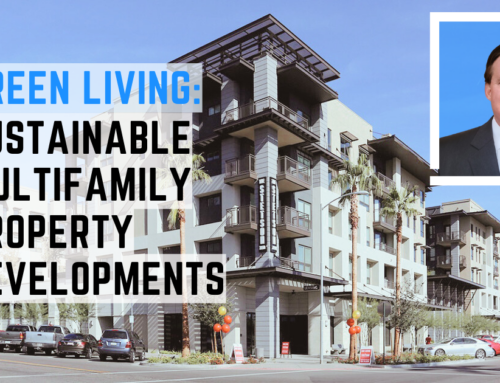2023 is indeed a very challenging time to get multifamily real estate deals done. Here is our Top 10 List for why this is the case:
1) Interest rates have gapped higher. While Investors may have gotten spoiled by Fannie and Freddie interest rates of around 3% during the Covid pandemic, interest rates are now around 6% from Fannie and Freddie agency lenders and around 9%-10% from bridge debt lenders. Even before the pandemic throughout 2015-2019, multifamily Investors could borrow from agency lenders at around 4.5%. So today’s rates are meaningfully higher than they were even before the Covid pandemic.
2) Multifamily deals offer negative leverage now. With interest rates so high, and most multifamily deals still selling at a true 4.5% – 5.0% cap rate (trued up for property taxes, insurance, real expenses, and replacement reserves) and 50-100 bps less on a yield to total cost basis, most multifamily deals offer meaningfully negative leverage in the first 12-24 months of ownership. Assuming a Fannie Mae 5-year fixed loan with two years of interest-only amortization and roughly 55%-60% of purchase price leverage (typical today), most multifamily deals are offering about 2%-3% cash on cash returns in year one and roughly 5.5% cash on cash over the 5-year holding period of the deal. Institutional Investors do not like negative leverage going into these deals!
3) Money Market accounts now offer 5.0% interest, about the same cash flow as multifamily deals but without any risk. Closely related to the negative leverage point above, both individual and Institutional Investors can get roughly the same cash flow in Treasuries or Money Markets that they can get in multifamily deals over a five-year hold, and better than what multifamily deals offer over the first 12-24 months of ownership. While we believe multifamily offers tax advantages and meaningful appreciation upside, some investors do not care about this and want less risk or no risk during these uncertain times.
4) Credit funds and publicly traded REITs offer high returns and instantaneous liquidity. Similar to the last point, some publicly traded REITs offer high dividends with discount to net asset values and with the liquidity that many people want. If Investors (individual or Institutional) can earn 9%-10% cash flow dividends on REITs trading at a discount to net asset value, and they can sell and liquefy their holdings anytime, that is good enough for many right now!
5) Institutional Investors are on the sidelines (protecting their jobs) or are only offering Pref Equity. Many Institutional Investors are totally on the sidelines right now or are only offering Pref Equity capital that is protected in the capital stack. Well, if everyone is Pref Equity, then who is the Common Equity in these deals? Enquiring minds want to know! Why many investors are totally and completely on the sidelines when pricing is down, 20%-30% is somewhat bewildering, but part of it has to do with career management…if an Investor buys now and it fails spectacularly, then they could be fired, but if an Investor does nothing right now their job is probably safe.
6) Sellers do not want to sell at lower prices unless they have to, creating a Buyer/Seller price divide. Many owners do not want to sell their multifamily deals at today’s market (lower) prices unless they have to. It is widely believed that interest rates will fall somewhat meaningfully in 2024, and some feel they will get a better price in 2024 or 2025 if they wait. This is especially true with those that have long-term fixed-rate debt, high cash flows, and no distress forcing them to sell. Why sell today at lower prices when one can sell tomorrow at better prices? This dynamic has created a gulf-sized Buyer/Seller price and expectations divide.
7) Much higher insurance and property taxes are squeezing NOI and killing deals. It is well known that multifamily insurance expenses have grown by 2x-4x over the past four years. Property taxes continue to shoot higher in places like Texas, Florida, the Carolinas, and other states that base property taxes off of recent trade prices. Texas, in particular, has seen some punishing property tax growth. Much higher insurance and property tax expenses are cutting down NOI and making it harder for Buyers and Sellers to come together, and this is hitting transaction volume meaningfully.
8) Higher interest rates means that debt leverage is lower, thus requiring much more equity to fund any given deal. Much higher interest rates have resulted in much lower leverage levels, typically in the 50%-60% of the purchase price, down from 70%-80% of the purchase price during the Covid free-money bubble. This means that deal Sponsors have to raise much more equity per deal to acquire a property, and given Investor hesitancy right now; this is a serious challenge to overcome.
9) There has been negative press about multifamily Sponsors that were too aggressive or over-leveraged. There have been various stories in the press and media about multifamily Sponsors who bought too many deals in 2021-2022 at high prices, with floating rate debt, that have lost investor money or acted in unscrupulous ways. Many read the Wall Street Journal article from April 2023 about the Houston syndicator who was over-leveraged and lost four of his properties to the bank (Fannie Mae via DUS Arbor). Others read the more recent Real Deal article about Tide Equities getting an expensive Equity injection from 3rd party property manager RPM Living. For some people, multifamily syndication has become a ‘dirty word.’ We do not agree this is the case at all, though there are deals out there from 2021-2022 that will turn into losers down the road. This is the reality of cyclical peaks and troughs and separates the long-term winners from the rest of the pack.
10) Everyone is waiting for distressed deals to come through at ridiculously low prices. Many Investors I pitch tell me they are waiting for meaningful market distress to roll through the market so they can buy multifamily deals at a sizable price discount to today’s already lower prices. So, people are waiting for these distressed deals to hit the market. The challenge here is that multifamily deals are performing well overall, Fannie and Freddie’s debt still supports the market even at 6% interest rates, and there is a lot of rescue capital out there that will give people lifelines. So, much of the distress that people are waiting for has not yet materialized in a meaningful way. Perhaps distress will materialize more in later 2023 or 1H’24, but with a strong economy and rates likely near a peak now, we think there could be less distress than what some are hoping for.
Navigating the Complexities: A 2023 Multifamily Real Estate Investment Outlook
The multifamily real estate landscape of 2023 presents a matrix of challenges, each intricately woven with the next. From soaring interest rates to changing investor sentiments and external pressures, the arena is undoubtedly complex. However, the very essence of real estate investment lies in the ability to forecast, adapt, and seize opportunities, even in trying times.
As a respected leader in the U.S. real estate investment industry, our firm’s track record speaks to our adeptness in navigating both booms and busts. While the list above paints a picture of the hurdles ahead, our experience tells us there’s always a silver lining – a strategy to be carved, a trend to be capitalized on.
If you’re an investor considering your next move or seeking guidance on multifamily real estate investments in these tumultuous times, let’s collaborate. We invite you to book a free strategy call with us. Harness the expertise of seasoned professionals, gain insights tailored to your unique investment profile, and navigate 2023 with confidence.
Empower your multifamily real estate investments with the right strategy.







Leave A Comment